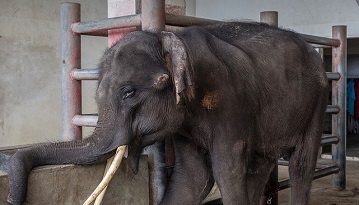 WASHINGTON, D.C.—National Geographic has unveiled a special investigative report that takes an in-depth look at the thriving global wildlife tourism industry and exposes how the industry takes advantage of people’s love of animals, often exploiting wildlife for profit from the moment they are born or captured until they die.
WASHINGTON, D.C.—National Geographic has unveiled a special investigative report that takes an in-depth look at the thriving global wildlife tourism industry and exposes how the industry takes advantage of people’s love of animals, often exploiting wildlife for profit from the moment they are born or captured until they die.
“The Hidden Cost of Wildlife Tourism,” featured on the cover of the June issue of National Geographic magazine and funded by the National Geographic Society, takes readers to a number of wildlife tourism encounters around the world, offering a look behind the curtain of an industry that has long presented itself as an animal lover’s fantasy. National Geographic uncovers that the reality the animals experience when the photo-snapping crowds head home can be one of extreme suffering and solitude.
In reporting the feature, National Geographic writer Natasha Daly, along with photojournalist Kirsten Luce, traversed the globe to secure a behind-the-scenes look at this lucrative segment of the booming global travel industry, visiting wildlife tourism facilities in Thailand, Russia, the United States and the Amazon. In many of these locales, wildlife tourism attractions leverage an increased demand for riding elephants; posing with tigers, bears and sloths; and more to lure visitors from around the world—and it’s working. International travel has doubled over the past 15 years, and social media is setting the wildlife tourism industry ablaze.
Animals Exploited
“The wildlife tourism industry clearly caters to people’s genuine love of animals, and the industry’s economy depends largely on people believing that the animals they’re paying to watch, ride or feed are having fun too,” says Daly. “But what we found in our reporting is that this is rarely the case. Instead, many businesses that have been bolstered by an increased demand for animal encounters seek to maximize their profits—and to do so, they’re exploiting animals from birth to death.”
Well-meaning endorsements from friends and trendsetters—especially on social media—legitimize potentially harmful and unethical attractions before travelers even arrive at these businesses that profit on the suffering of animals. At the same time, selfies of tiger encounters, elephant rides and more offer viral advertising for attractions that tout up-close exotic animal experiences—so much so that from 2014 to 2016 the number of wildlife selfies posted on Instagram alone nearly quadrupled. But, for all the visibility social media provides, it rarely illustrates the animal abuse that often happens beyond the view of the camera lens.
“Nowhere is humans’ profound love of animals more apparent than at National Geographic, where photos of animals are among the most ‘liked’ by our social media followers, stories about animals drive significant traffic across our website and animals are prominent in the pages of our magazine,” says Susan Goldberg, Editor-in-Chief of National Geographic. “But, as our reporting found, too often this industry takes advantage of people’s love of animals. In sharing this reporting, we hope this complicated but important topic gets the attention it deserves.”
Practical Advice for Travelers
National Geographic’s reporting includes practical advice for travelers who want to experience close encounters with wildlife, but in humane and ethical ways. See “How to Do Wildlife Tourism Right” from the June issue of National Geographic Traveler magazine, available online HERE, offering practical guidelines for travelers.
To accompany “The Hidden Cost of Wildlife Tourism,” National Geographic has produced a 13-minute documentary, “Inside the Dark World of Captive Wildlife Tourism.” The behind-the-scenes footage illustrates Daly’s reporting and reactions in real time as she witnesses firsthand the animal abuse often facilitated by the industry. View the documentary HERE. The documentary will also be available on set-top box video on demand and TV Everywhere platforms, including the Nat Geo App and on NatGeoTV.com.
In addition, National Geographic will be enacting a social media campaign, encouraging audiences to help educate others about these wildlife tourism practices and make informed choices. Follow along using #NatGeoWildlifeTourism and see the social toolkit for more information, including a shareable photo, HERE. Instagram Stories will make use of the new donation feature recently introduced on the platform, allowing fans to help fund the journalism that brings issues like the exploitation of wildlife to light (donate.ngs.org/wildlife-watch).
The story was reported by Daly for Wildlife Watch, an investigative journalism project funded by the nonprofit National Geographic Society that reports on wildlife crime and exploitation. By covering critical topics in the illegal wildlife trade, this project shines a light on the commercial-scale exploitation of wildlife and other valued resources, identifies weaknesses in national and international efforts to protect wildlife, and empowers institutions and individuals working to save at-risk species.
“Wildlife Tourism” is available online now at natgeo.com/wildlifetourism and on print newsstands May 28.





